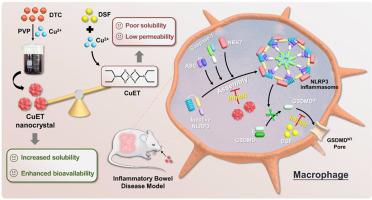当前位置:
X-MOL 学术
›
Acta Pharm. Sin. B
›
论文详情
Our official English website, www.x-mol.net, welcomes your feedback! (Note: you will need to create a separate account there.)
Repurposing disulfiram with CuET nanocrystals: Enhancing anti-pyroptotic effect through NLRP3 inflammasome inhibition for treating inflammatory bowel diseases
Acta Pharmaceutica Sinica B ( IF 14.5 ) Pub Date : 2024-03-15 , DOI: 10.1016/j.apsb.2024.03.003 Xueming Xu , Yuanfeng Han , Jiali Deng , Shengfeng Wang , Shijie Zhuo , Kai Zhao , Wenhu Zhou
Acta Pharmaceutica Sinica B ( IF 14.5 ) Pub Date : 2024-03-15 , DOI: 10.1016/j.apsb.2024.03.003 Xueming Xu , Yuanfeng Han , Jiali Deng , Shengfeng Wang , Shijie Zhuo , Kai Zhao , Wenhu Zhou

|
Drug repurposing offers a valuable strategy for identifying new therapeutic applications for existing drugs. Recently, disulfiram (DSF), a drug primarily used for alcohol addiction treatment, has emerged as a potential treatment for inflammatory diseases by inhibiting pyroptosis, a form of programmed cell death. The therapeutic activity of DSF can be further enhanced by the presence of Cu, although the underlying mechanism of this enhancement remains unclear. In this study, we investigated the mechanistic basis of Cu-induced enhancement and discovered that it is attributed to the formation of a novel copper ethylthiocarbamate (CuET) complex. CuET exhibited significantly stronger anti-pyroptotic activity compared to DSF and employed a distinct mechanism of action. However, despite its potent activity, CuET suffered from poor solubility and limited permeability, as revealed by our druggability studies. To overcome these intrinsic limitations, we developed a scalable method to prepare CuET nanocrystals (CuET NCs) using a metal coordination-driven self-assembly approach. Pharmacokinetic studies demonstrated that CuET NCs exhibited a 6-fold improvement in bioavailability. Notably, CuET NCs exhibited high biodistribution in the intestine, suggesting their potential application for the treatment of inflammatory bowel diseases (IBDs). To evaluate their therapeutic efficacy , we employed a murine model of DSS-induced colitis and observed that CuET NCs effectively attenuated inflammation and ameliorated colitis symptoms. Our findings highlight the discovery of CuET as a potent anti-pyroptotic agent, and the development of CuET NCs represents a novel approach to enhance the druggability of CuET.
中文翻译:

用 CuET 纳米晶体重新利用双硫仑:通过 NLRP3 炎症小体抑制增强抗焦亡作用,用于治疗炎症性肠病
药物再利用为确定现有药物的新治疗应用提供了有价值的策略。最近,双硫仑 (DSF) 是一种主要用于治疗酒精成瘾的药物,通过抑制细胞焦亡(一种程序性细胞死亡),已成为治疗炎症性疾病的潜在药物。 Cu 的存在可以进一步增强 DSF 的治疗活性,尽管这种增强的潜在机制仍不清楚。在这项研究中,我们研究了铜诱导增强的机制基础,发现其归因于新型乙基硫代氨基甲酸铜(CuET)络合物的形成。与 DSF 相比,CuET 表现出明显更强的抗焦亡活性,并且采用了独特的作用机制。然而,正如我们的成药性研究所揭示的那样,尽管 CuET 具有强大的活性,但其溶解度差且渗透性有限。为了克服这些固有的局限性,我们开发了一种可扩展的方法,使用金属配位驱动的自组装方法来制备 CuET 纳米晶体 (CuET NC)。药代动力学研究表明,CuET NC 的生物利用度提高了 6 倍。值得注意的是,CuET NCs 在肠道中表现出较高的生物分布,表明它们在治疗炎症性肠病(IBD)方面具有潜在的应用前景。为了评估它们的治疗效果,我们采用了 DSS 诱导的结肠炎小鼠模型,并观察到 CuET NC 有效减轻炎症并改善结肠炎症状。我们的研究结果强调了 CuET 作为一种有效的抗焦亡剂的发现,并且 CuET NC 的开发代表了一种增强 CuET 成药性的新方法。
更新日期:2024-03-15
中文翻译:

用 CuET 纳米晶体重新利用双硫仑:通过 NLRP3 炎症小体抑制增强抗焦亡作用,用于治疗炎症性肠病
药物再利用为确定现有药物的新治疗应用提供了有价值的策略。最近,双硫仑 (DSF) 是一种主要用于治疗酒精成瘾的药物,通过抑制细胞焦亡(一种程序性细胞死亡),已成为治疗炎症性疾病的潜在药物。 Cu 的存在可以进一步增强 DSF 的治疗活性,尽管这种增强的潜在机制仍不清楚。在这项研究中,我们研究了铜诱导增强的机制基础,发现其归因于新型乙基硫代氨基甲酸铜(CuET)络合物的形成。与 DSF 相比,CuET 表现出明显更强的抗焦亡活性,并且采用了独特的作用机制。然而,正如我们的成药性研究所揭示的那样,尽管 CuET 具有强大的活性,但其溶解度差且渗透性有限。为了克服这些固有的局限性,我们开发了一种可扩展的方法,使用金属配位驱动的自组装方法来制备 CuET 纳米晶体 (CuET NC)。药代动力学研究表明,CuET NC 的生物利用度提高了 6 倍。值得注意的是,CuET NCs 在肠道中表现出较高的生物分布,表明它们在治疗炎症性肠病(IBD)方面具有潜在的应用前景。为了评估它们的治疗效果,我们采用了 DSS 诱导的结肠炎小鼠模型,并观察到 CuET NC 有效减轻炎症并改善结肠炎症状。我们的研究结果强调了 CuET 作为一种有效的抗焦亡剂的发现,并且 CuET NC 的开发代表了一种增强 CuET 成药性的新方法。



























 京公网安备 11010802027423号
京公网安备 11010802027423号